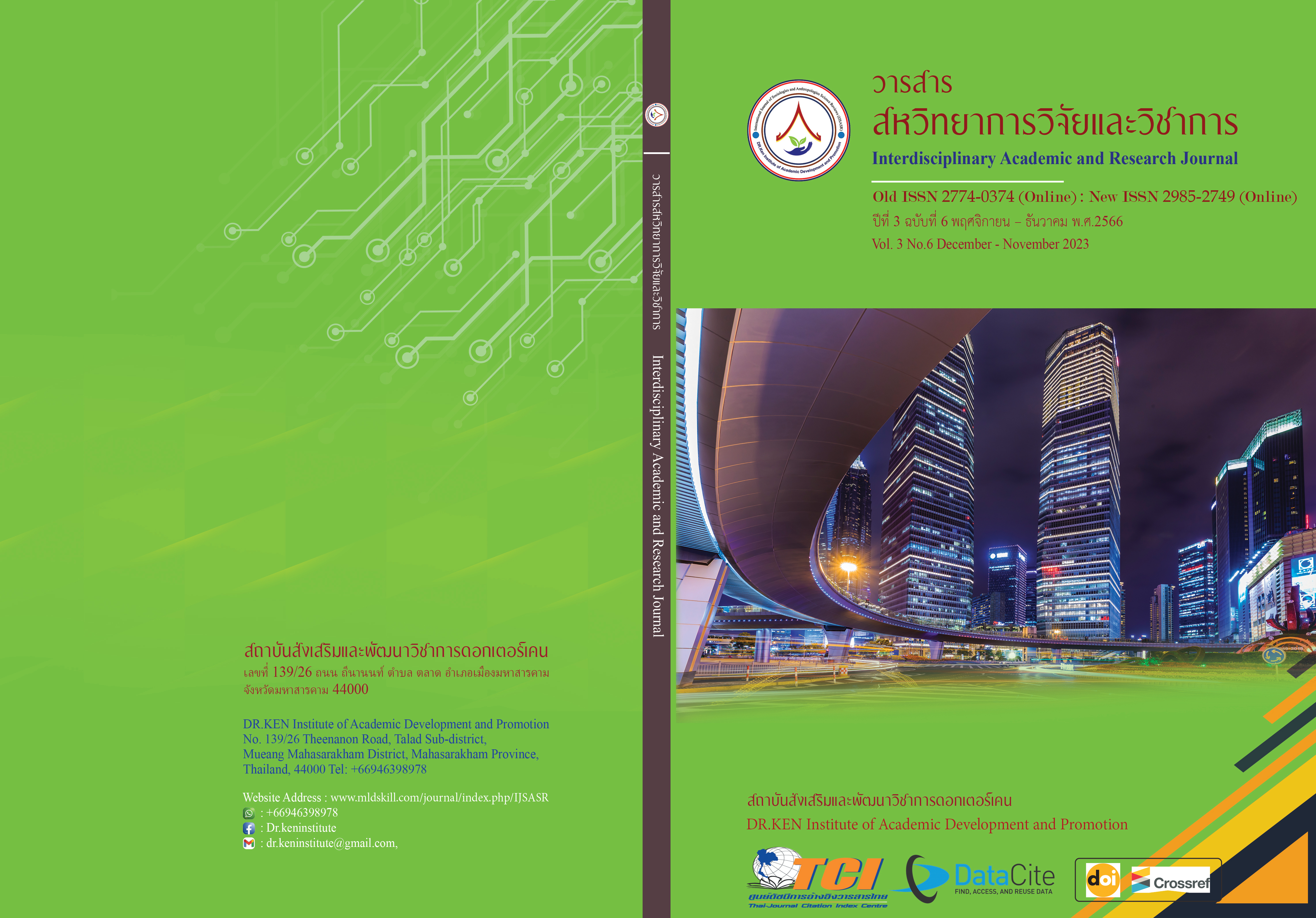Pottery Value-Added Innovation According to the guidelines of the Integration Sufficiency Economy by Participation Communities at Banmaungnoi, Chaiyaphum Province
DOI:
https://doi.org/10.60027/iarj.2023.270610Keywords:
Value-added Innovation; , Earthenware; , Integrated Sufficiency Economy; , Participation in CommunityAbstract
Background and Aims: Ban Mueang Noi, Chaiyaphum Province, is a village famous for producing quality pottery that has been passed down for a long time. From studying the limitations of production and marketing currently, there are only 2 types of products, namely cooking stoves, and tone only. The researcher is therefore interested in organizing the process of designing an innovative bas-relief print to increase the value of pottery in the Ban Mueang Noi community, Chaiyaphum Province, to increase the production channels for a variety of products that meet the needs of consumers in many groups, such as tourists, students, youth, etc. Examples of products include decorative ornaments, household or garden items, children's toys, souvenirs, and souvenirs, etc. by the innovative design process of bas-relief printing that has integrated knowledge. This research is action research with objectives; (1) To study the historical context and explore problems in the production of pottery in the Ban Mueang Noi community, Chaiyaphum Province. And (2) To design an innovation to increase the value of pottery according to the Sufficiency Economy concept, integrated with the participation of the community, Ban Muang Noi, Chaiyaphum Province.
Methodology: The population used in the research was a survey of 100 people in Chaiyaphum Province and 10 pottery producers. The research tools include (1) an interview with a village scholar, (2) a population opinion questionnaire, and (3) a questionnaire on satisfaction with the efficiency of pottery value-adding innovations according to the integrated sufficiency economy concept. Descriptive statistics were used to analyze the data and content analysis was used to analyze the qualitative data.
Results: The research results found that; Innovative relief printing can create a variety of designs, create different products, and create another channel for producing products for the community. The innovative design process for bas-relief printing integrates the knowledge and cooperation of people in the community according to the Sufficiency Economy principle. Participation starts at the level of awareness, expressing opinions, Learning, taking action, receiving benefits, and sharing responsibility. It creates help and support, knowledge of love and unity, strengthens families and communities, promotes the economy, strengthens community relations, and preserves the good arts and culture of the local area to survive, and prosper forever. The innovation of bas-relief printing allows for a variety of product styles, and raw materials for production can be obtained locally, saving time, and allowing for mass production. The product has artistic beauty and is suitable for adding value to the pottery of the Ban Muang Noi community. Satisfaction with the efficiency of the innovation of relief printing from pottery manufacturers has a mean of 4.06, a standard deviation of 0.46.
Conclusion: Low-cost, low-relief printing innovations can create a variety of products and help create alternative production channels for communities. Integration of knowledge and cooperation in the Sufficiency Economy promotes community participation and participation in promoting local culture. There is a high satisfaction from local pottery producers.
References
เกรียงศักดิ์ เจริญวงศ์ศักดิ์. (2546). การคิดเชิงบูรณาการ. กรุงเทพฯ : ซัคเซสมีเดียร์.
เบญจมาศ อภิสิทธิ์ภิญโญ. (2555). การบัญชีต้นทุน 1. กรุงเทพฯ : ซีเอ็ดยูเคชั่น.
ชัยชาญ จันทศรี. (2557). กระบวนการทำพิมพ์และหล่อมีความสำคัญต่อการปั้นรูปประติมากรรมจริงหรือ. มหาวิทยาลัยราชมางคลรัตนโกสินทร์.
ทองอินทร์ คงชัย. (1 พฤศจิกายน 2564). สัมภาษณ์. ปราชญ์ชาวบ้าน.
พลสวัสดิ์ มุ่มบ้านเช่า. (2553). ประติมากรรม. กรุงเทพฯ : สุวีริยาสาส์น.
พวงรัตน์ ทวีรัตน์. (2540). วิธีการวิจัยทางพฤติกรรมศาสตร์และสังคมศาสตร์. กรุงเทพฯ : มหาวิทยาลัยศรีนครินทรวิโรฒ ประสานมิตร.
มูลนิธิชัยพัฒนา. (2564). เศรษฐกิจพอเพียง. Retrieved on 3 November 2021 from: https://www.chaipat.or.th/publication/publish-document/sufficiency-economy.html
วรสุดา ขวัญสุวรรณ และสาทินี วัฒนกิจ (2563). การสร้างมูลค่าเพิ่มให้กับวัสดุเหลือทิ้งสู่ผลิตภัณฑ์ออกแบบตกแต่ง และแฟชั่น: ชุมชนต้นแบบเทศบาลเมืองเขารูปช้าง. มหาวิทยาลัยเทคโนโลยีราชมงคลศรีวิชัย.
วริศรา สมเกียรติกุล และ กมล เรืองเดช (2564). การสร้างมูลค่าเพิ่มให้กับข้าวหอมไชยาพันธุ์พื้นเมือง อำเภอไชยา จังหวัดสุราษฎร์ธานี.วารสารวิจัยและพัฒนา มหาวิทยาลัยราชภัฏเลย,16 (56),31-42.
วิชัย วงษ์ใหญ่ และมารุต พัฒผล. (2562). การบูรณาการเชิงสร้างสรรค์ (Creative Integration). กรุงเทพฯ: ศูนย์ผู้นำนวัตกรรมหลักสูตรและการเรียนรู้.
ศุภชัย สิงห์ยะบุศย์. (2542). การเปรียบเทียบลักษณะและรูปแบบศิลปะและการจัดเครื่องปั้นดินเผา ด่านเกวียน อำเภอโชคชัย นครราชสีมา กับบ้านหม้อ อำเภอเมือง มหาสารคาม. มหาสารคาม: มหาวิทยาลัยมหาสารคาม
สถาบันพระปกเกล้า. (2564). การมีส่วนร่วม. Retrieved on 5 November 2021 from: http://wiki.kpi.ac.th/index.php?title=การมีส่วนร่วม
สำนักงานคณะกรรมการพิเศษเพื่อประสานงานโครงการอันเนื่องมาจากพระราชดำริ, (2564). เศรษฐกิจพอเพียง. Retrieved on 5 November 2021 from: https://www.rdpb.go.th/th/Sufficiency
สำนักงานนวัตกรรมแห่งชาติ, (2564). ความหมายของนวัตกรรม. Retrieved on 5 November 2021 from: http://it.east.spu.ac.th/informatics/admin/knowledge/A307Innovation%20and %20Technology.pdf.
สุขุมาล สาระเกษตริน. (2564). เครื่องปั้นดินเผาการออกแบบและปฏิบัติงาน.กรุงเทพฯ : สำนักพิมพ์ 50 Press Printing.
สุจินดา เจียมศรีพงษ์ และปิยวัน เพชรหมี. (2560). การสร้างมูลค่าเพิ่มของผลิตภัณฑ์จากภูมิปัญญาท้องถิ่น ไทย: กรณีศึกษาผ้าทอลายโบราณ. Journal of Community Development Research (Humanities and Social Sciences), 10 (4), 62-85.
สุภาพร วิชัยดิษฐ์, ศกลวรรณ คงมานนท์ และ พุธรัตน์ บัวตะมะ. (2565). การเพิ่มมูลค่าภูมิปัญญาผ้าทอท้องถิ่นสู่การท่องเที่ยวเชิงสร้างสรรค์. วารสารเทคโนโลยีคหกรรมศาสตร์และนวัตกรรม. 7 (3), 347-364.
Beane, J.A. (1991). Curriculum Planning and Development. Boston: Ally and Bacom.
Downloads
Published
How to Cite
Issue
Section
License
Copyright (c) 2023 Narudom Pinthong

This work is licensed under a Creative Commons Attribution-NonCommercial-NoDerivatives 4.0 International License.
Copyright on any article in the Interdisciplinary Academic and Research Journal is retained by the author(s) under the under the Creative Commons Attribution-NonCommercial-NoDerivatives 4.0 International License. Permission to use text, content, images, etc. of publication. Any user to read, download, copy, distribute, print, search, or link to the full texts of articles, crawl them for indexing, pass them as data to software, or use them for any other lawful purpose. But do not use it for commercial use or with the intent to benefit any business.
















.png)


